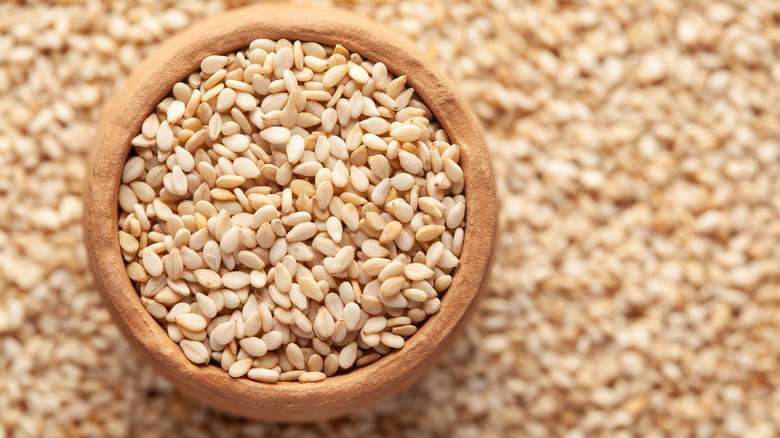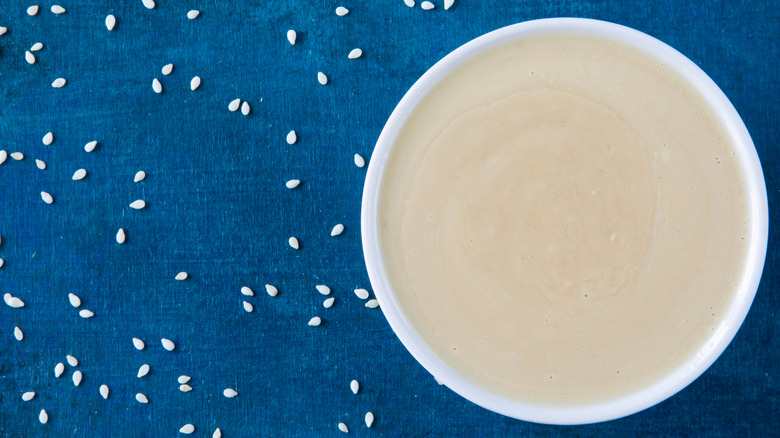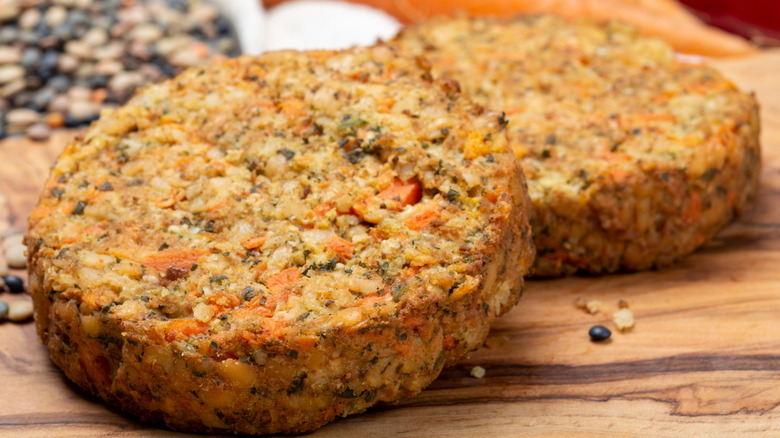12 Foods To Avoid If You Have A Sesame Allergy
When we think of allergies, we tend to cast our minds toward a few usual suspects: Pollen causing hay fever symptoms, animal fur making your eyes water, and potentially dangerous bee stings. But food allergies are also widespread, and amongst the more well-known food allergy triggers like nuts, wheat, and milk, there are a few allergens that are on the rise.
Sesame is one such trigger. Once a lesser-seen allergy, sesame allergies have become way more widespread in the last few decades, and they now affect over 0.2% of U.S. adults and children, according to Food Allergy Research & Education. The allergy has become so widespread that beginning on January 1, 2023, it will be a requirement to label sesame as a potentially triggering ingredient on food packaging, as a major allergen.
The problem, though, is that sesame is all over the place, showing up in foods that you didn't even know it could be included in. And rather troublingly, the rules around whether food companies have to name it as an allergen on food packaging are still somewhat hazy. That's why we decided to throw together a list of foods that you should absolutely be checking the label of (and avoiding) if you have a sesame allergy.
Hummus has sesame packed into it
Hummus may be one of the most popular spreads around the world, but for people with sesame allergies, it can be a pretty dangerous dip. Hummus is known for being a dip made from chickpeas, but a large part of its flavor comes from tahini, a ground sesame paste, as seen in Fresh Cravings Classic Hummus (via Walmart) and nearly every other hummus brand out there. This leads to this simple dip being firmly off-limits if you're buying it in its classic form.
However, there is a range of brilliant substitutes for tahini out there for hummus, provided that you're willing to make it yourself at home (which we're willing to say is probably a lot more fun, and maybe way healthier, too). To retain the nutty taste that tahini gives, try throwing in peanut butter, suggests Martha Stewart (unless you have a peanut allergy, of course). Greek yogurt can also be a great way to emulate the creamy texture that tahini provides, while steamed sweet potato, avocado, or roasted red peppers can make a delicious vegan addition, and will also boost the fiber and vitamin content of your dip.
Sausages, and other processed meats, sometimes come with sesame included
If you're buying sausages at the store, you're probably well aware that certain brands don't just have meat in them. But what you might not be expecting is the presence of certain products like sesame. Unfortunately, folks, if you have a sesame allergy, it may be best to avoid sausages and processed meats altogether. Otherwise, check the label of the brand you've got your eye on very carefully, as these meat products can frequently have sesame lurking in them (per Food Allergy Research & Education).
But ... why? Why do sausages have sesame seeds in them, of all things? There are a few reasons. The first is for the additional flavor and texture that ground sesame seeds or sesame oil could provide to the meat. There's also the fact that sesame paste may act as a slightly healthier fat substitute, according to research published in the International Journal of Engineering and Technology. Researchers found that using ground sesame paste in hamburgers may bring down the level of bad cholesterol in the products, and increase their unsaturated fat content while reducing saturated fat levels overall. Great news for people who want a slightly healthier burger, but less good for people with a sesame allergy.
Watch out for the type of bread you're purchasing
On the surface of things, bread might seem like a pretty basic food choice that's safe for people with most allergies (well, unless you have a wheat allergy, that is, in which case you better be careful). But bread is one of the top foods that you should avoid if you have a sesame allergy, according to Medical News Today.
Sesame and sesame products are frequently used to add flavor to bread, with sesame oil added to products like Wegmans Marco Polo Bread, according to GreenChoice. Sesame seeds are also often sprinkled on the top of bread or throughout the dough, to give the products an added texture.
Unfortunately, it's not just your everyday loaf that you have to watch out for sesame in. Sesame can also show up in a huge amount of bakery products. Breadsticks and breadcrumbs may also contain sesame products, and bagels and hamburger buns are often adorned with sesame seeds for a little crunch. If you're buying baked goods from a store, make sure to look at the label carefully. Buying in a bakery can be a little tricker, thanks to the risk of cross-contamination, but ensure that you're asking your baker about the potential for sesame in your bread.
Tempeh may be a good meat substitute — but not for people with sesame allergies
In a world where plant-based alternatives are skyrocketing in popularity, people are looking a little further than tofu to replace their meat, and tempeh's showing up in more and more grocery baskets. But if you've got a sesame allergy, this could be a serious problem.
Although tempeh is primarily made by pressing together cooked, fermented soybeans, it can also frequently contain sesame seeds, warns Chartwells K-12 vice president of culinary, nutrition, and sustainability and registered dietitian Margie Saidel (via Women's Health Magazine). Naturally, the soybeans that tempeh is made from also make it unsuitable for anyone with a soy allergy.
As such, if you're looking for a meat substitute that doesn't contain sesame, opting for tofu or using protein-rich beans could be a great alternative. Just be aware of how you're cooking your plant-based protein, though. Meat substitutes can often be used in dishes that contain sesame in some other form, either through sesame oil as flavoring or sesame seeds, so it's wise to always check the label or with your restaurant server.
Check the label of the margarine you're buying
Margarine has long been used as a butter substitute, and for people following dairy-free diets, it's nothing short of a miracle. But it can present a fair amount of problems in other areas, especially for people who have sesame allergies. While you might not expect the presence of sesame in your margarine tub, sesame oil is frequently used in the butter substitute, according to Allergy Insider. Sesame oil may also be used in shortening brands.
But is sesame oil that bad for you if you have a sesame allergy? We can see why you might ask the question: After all, certain people with soy or peanut allergies may be totally fine to eat highly refined soybean oil or peanut oil, as Food Allergy Research & Education states. However, the reason those oils may be safe for consumption is because of the refinement process they go through. Sesame oil, on the other hand, is not highly refined, and as a result, remains dangerous to people with allergies. If you have any doubts about what you can or can't eat with a sesame allergy, speak to your doctor.
Anything with tahini in it will be a trigger
So you're looking for sesame-free products in your store, and you pick up some baba ghanoush, or maybe a new brand of falafel. You check the ingredients list. No sesame seeds, it looks like ... Great! But there's this thing called "tahini," and it's probably fine to eat, right?
Well ... Maybe not. If you're not familiar with tahini yet, you need to know that it's essentially pure sesame, a paste that's usually made from ground sesame seeds, oil, and a little salt (per BBC Food). And naturally, that can be super troublesome for anyone who's trying to avoid sesame, especially if a recipe you're making calls for it. The good news, though, is that there's a wide range of foods that you can use in place of tahini that will allow you to avoid sesame while also enjoying the creaminess that the paste gives a dish. Sunflower seed butter can provide you with a similar texture, especially when blended with canola oil, according to Pure Wow. Almond or cashew butter are also great substitutes, with a similar nuttiness to tahini provided in the pastes.
Granola brands are not all sesame-free
Ah, granola. Just the thought of a heaping bowl in the morning is enough to get even the most reluctant of people out of bed and getting on with their day. But unfortunately, if you have a sesame allergy, you might be better off avoiding granola entirely, or at least being very careful about which brand you're going for.
Granola formulations can frequently contain sesame seeds alongside other nuts and seeds, making them inedible for people with allergies. Crucially, too, sesame seeds may show up in granola recipes that may seem to have other flavorings entirely, with Bob's Red Mill Maple Sea Salt Granola containing sesame seeds, despite the dominant flavor profile of the product being different (via Walmart).
Also, bear in mind that on your granola packet (or food ingredients lists in general), sesame may be showing up by a different name entirely. "Benne seed," "benniseed," or just plain old "benne" are all names that indicate the presence of sesame, as are "tahini" and "halvah," says Food Allergy Research & Education. "Sim sim," "sesamol" and "sesemolina" are some of the other names that you should look out for.
Baklava and other sweets can often have sesame in them
There's nothing quite like baklava. The syrupy, crunchy, chewy dessert is a favorite on Greek and Turkish menus everywhere, and for many, it's the highlight of their meal. Apart from if you have a sesame allergy, that is. Baklava recipes frequently use sesame, as well as nuts like pistachios and almonds, to generate depth of flavor and texture. Sesame is especially common in seasonal variations of Greek baklava and during Lent periods, according to Greek Boston.
Fortunately, though, if you eat sesame, you don't have to go without your baklava fix forever — and if you were so inclined, you can whip up a batch of sesame-free baklava at home. Grab yourself some dried apricots, dates, and raisins, and blitz them in a processor with some sugar and cinnamon, says Easy and Delish. Brush a sheet of filo pastry with some butter, place it into a rectangular pan, and spread your fruit mixture on top of it. Layer the pastry and mixture and then, when you get to the top, slice the lasagne-esque concoction you've just made into squares. Place in an oven to bake at 400 degrees Fahrenheit for 30-40 minutes, and when it's fully cooked, take it out, pour syrup over it, and allow it to cool. Sesame-free and utterly delicious!
Certain salad dressings will contain sesame
Let's face it, certain salads can be incredibly boring until the right salad dressing comes along. And when it does, things go from 0 to 100 pretty quickly. Things can equally go downhill again, though, if your salad dressing contains sesame, which a surprising amount of them do.
Sesame-based dressings are especially common these days, particularly in Asian-inspired salads, and they'll usually be branded as such. Where it becomes troublesome, though, is when they're not. In Ocean's Halo Vegan Tangy Thai Dressing, for example, you wouldn't know that there's any sesame in it from looking at the front label on the bottle, and it's only when you read the back description that the sesame becomes apparent (per Walmart).
And things can become even more complicated if you're buying an already-dressed salad in a store, or having one at a buffet, where sesame oil might be included without you knowing. Save yourself the hassle and potential allergen triggers, and make your own dressing at home, with an easy Thai peanut dressing created by combining soy sauce, lime juice, white vinegar, ginger, garlic, and the star ingredient, peanut butter (per Two Sleevers).
Be careful when you're buying candy
What do you expect to be in your candy? Sugar, of course, and maybe a host of difficult-to-identify flavorings, additives, and preservatives? There's a lot to be said about candy not exactly being a healthy food thanks to its extensive ingredients list, but we don't usually assume sesame will show up. Regrettably, that can frequently be the case in some candy products.
Candy corn, for example, may be made with sesame oil, and could be potentially very problematic for people with sesame allergies, as Food Allergy Research & Education states. Sesame can also show up in chocolate products, and other candies that you assume could be safe may have a slightly different formulation if it's coming in a "mini" size, which further complicates what you can expect from their ingredients. This is all made even more tricky by the fact that candy manufacturers aren't obligated to put sesame products on their labels as an allergen until January 1, 2023. And even if they have put it on the label, how do you know if the candy corn in that Halloween tub contains sesame or not? It's best to be on your guard, and buy products for yourself or your kids that you know don't contain sesame.
Certain vegetarian meat substitutes may contain sesame
With more and more people cottoning on to the various impacts of eating meat (both environmental and physical, with processed meat potentially increasing your risk of cancer and heart disease, according to the Harvard T.H. Chan School of Public Health), it's little surprise that vegetarian meat substitutes are growing increasingly popular every day. But if you have a sesame allergy, it's highly important to check the label. Vegetarian burgers, in particular, can contain sesame products, according to Medical News Today. And that could be before you find the perfect bun to put it in, which may be — you guessed it — topped with sesame seeds.
Given the increasingly innovative ways that plant-based meat substitute pioneers are creating their products, keeping an eye on ingredient lists is more important than ever. One place you can feel safe if you have a sesame allergy, however, is with Impossible Foods. Their meat-free products, including their burgers, plant-based chicken nuggets, and meatballs, are not made with sesame, according to the Impossible Foods website. That said, they are made with other foods that could provoke an allergic response in some people, like soy and wheat.
Your protein bar could have sesame hiding in it
We generally expect our protein bars to have ... Well ... Protein in them, right? Well, you'd be right to think so — but they often have more besides that.
Various protein and energy bars can contain sesame or sesame-derived products, according to Medical News Today, making them pretty complicated for people with sesame allergies to buy and consume safely. Tone It Up Plant Based Protein Bars, for example, can contain sesame, especially in their Chocolate Peanut Butter version (per Walmart). Other energy or protein bars may not contain sesame specifically, but may be made in a facility that processes them, such as KIND Bars, making the question of whether they're safe to eat or not a bit more complicated.
But this is the modern world, folks, and luckily, there are still options out there for you to get your protein kick while also keeping things sesame-free. Try ZEGO Bars out for size, Food Allergy Parents suggests. With six grams of protein per serving, these bars aren't just free from sesame, but a huge range of allergens, thanks to ZEGO's emphasis on creating the most allergy-friendly products possible. ZEGO Bars are also made primarily using organic ingredients, which we absolutely love.
Sesame products can show up in non-food products, too
If you're trying to watch your sesame intake, it's not just foods you have to watch out for. There's a huge range of products out there that can contain sesame or sesame-derived ingredients, and you could be buying them without even realizing it.
The first place you should start checking labels more carefully is in the skincare aisle. Cosmetic products can include sesame oil for their benefits to the skin that may provoke a cosmetic reaction, but somewhat surprisingly, can also be labeled as "Allergy Tested" despite the presence of the allergen (via Allergy UK). And even if a product contains sesame, it may not even be labeled as sesame: Look out for Sesamum Indicum on labels.
Elsewhere, sesame can show up in food products that aren't even for yourself — or humans, in general. The seed and products made from it can be part of pet food recipes, making checking the label for them essential, according to Allergic Living. Sesame can also be part of formulas for sunscreen, and even in medicinal products. In short, never assume that just because something isn't food you're planning on eating, it won't have an impact on you if you have an allergy.
What do you do if you're experiencing an allergic reaction to sesame?
If you have a sesame allergy or know someone who does, it's highly important to be aware of how to respond when symptoms occur. The tiniest amount of sesame in food can provoke a response, and symptoms can range from mild to life-threatening, with everything from itchy eyes to vomiting and diarrhea, and even loss of consciousness and breathing difficulties possible (per Kids Health).
When an allergic reaction occurs, it's vital to respond immediately. For milder reactions, they may be able to be treated using antihistamines, according to the NHS. With more severe symptoms, the use of an epinephrine pen (or EpiPen) might be required, to auto-inject medication into the system that starts to combat the allergic response. EpiPens should be used as soon as possible when there are symptoms like trouble breathing or wheezing, or combined symptoms across the body like vomiting with hives, Kids Health says.
While you're conducting your first aid, call 911 immediately, so that trained healthcare professionals can deliver medical assistance as soon as possible. It's vital to carry an EpiPen with you wherever you go, if you or a loved one have a sesame allergy, just in case.















